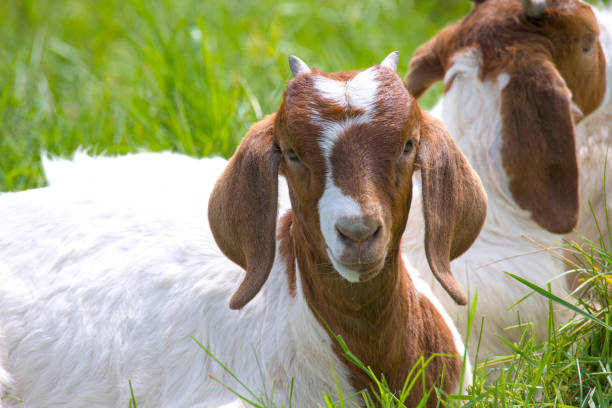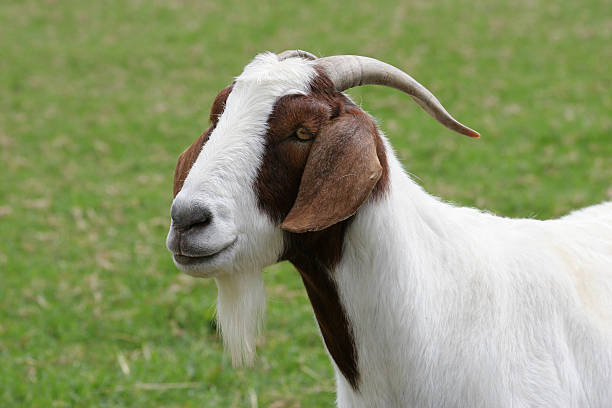- Basinikonda, Madanapalle, Annamayya (Dist), AP, Pin - 517325.
- imforupvtltd@gmail.com
About Goat Farming....
Introduction to Goat Farming
Goat Farming, also known as goat husbandry, involves the breeding and management of domestic goats for a variety of Valuable Products—including Meat, Milk, Fiber (like cashmere and mohair), and hides. Known for their adaptability and resilience, goats can thrive in diverse climates and terrains, making goat farming a flexible and profitable agricultural venture suitable for both small-scale and commercial operations.
Key Aspects of Goat Farming:
1. Goat Breeds and Their Purposes
Different goat breeds are selected based on the desired production goal:
Meat Production
Boer, Kiko, and Spanish goats are well-known for their size, hardiness, and rapid weight gain—making them ideal for meat production.Milk Production
Saanen, Alpine, and Nubian goats are among the top dairy breeds, prized for their high milk yield and quality.Fiber Production
Angora goats produce soft and valuable mohair, while Cashmere goats yield luxurious cashmere wool.Dual-Purpose Breeds
Breeds like the Nubian offer the advantage of both milk and meat production, making them suitable for mixed-use farming.
2. Housing and Shelter
Proper housing ensures goat health, comfort, and productivity:
Goat Barns/Sheds
Structures should be dry, well-ventilated, and offer protection from extreme weather conditions.Pasture Shelters
Simple, shaded areas in grazing fields provide relief from sun, wind, and rain.Fencing
Strong, secure fencing is essential to prevent escapes and guard against predators—especially in rural or open areas.
3. Feeding and Nutrition
Balanced nutrition plays a critical role in maintaining healthy and productive goats:
Forage
Goats are natural browsers and thrive on a mix of grasses, leaves, shrubs, and quality hay.Supplements
Grain-based feeds and mineral supplements are especially important for pregnant or lactating does and growing kids.Water
Goats must always have access to clean, fresh water for optimal health and digestion.



4. Breeding and Reproduction
Effective breeding practices are key to maintaining a healthy and productive goat herd:
Breeding Season
Most goats are seasonal breeders, typically coming into heat during the fall, with births occurring in late winter or early spring.Kidding Management
Careful monitoring and assistance during the kidding (birthing) process help improve kid survival rates and ensure the well-being of both mother and offspring.Health of Breeding Stock
Breeding bucks and does should receive regular health checks, a balanced diet, and proper care to maintain fertility and overall herd quality.
5. Health Management
Maintaining herd health is essential for productivity and longevity:
Vaccinations
Routine immunizations help prevent common diseases such as enterotoxemia, tetanus, and pneumonia.Parasite Control
Implement a consistent deworming schedule and manage external parasites like lice and ticks to avoid infestations and maintain herd vitality.Hoof Care
Regular hoof trimming prevents lameness and infections, contributing to the goats’ overall mobility and comfort.
6. Milk Production
For dairy operations, consistent management is critical to high-quality milk output:
Milking Routine
Goats should be milked regularly—typically twice daily—to sustain milk flow and maintain udder health.Milk Handling
Strict hygiene practices during milking and proper storage techniques are vital to ensure the milk remains clean, fresh, and safe for consumption or processing.



7. Meat Production
Efficient meat production in goats requires careful management to maximize yield and quality:
Growth Management
Provide a balanced diet and maintain optimal housing conditions to support healthy weight gain and fast growth in meat breeds.Processing Practices
Follow humane and efficient butchering methods, adhering to safety and ethical standards to produce high-quality meat products.
8. Fiber Production
For fiber-producing goats, proper care ensures the production of valuable textiles:
Shearing Schedule
Angora and Cashmere goats require routine shearing—typically once or twice a year—to harvest mohair or cashmere fibers.Maintaining Fiber Quality
Good nutrition, parasite control, and overall health care are essential for producing clean, strong, and marketable fiber.9. Economic Considerations
Goat farming can be a profitable venture when managed effectively:
Market Research
Understand the demand for goat products—meat, milk, and fiber—both locally and internationally to optimize sales and production.Cost Management
Keep operational expenses such as feed, healthcare, and infrastructure under control to maintain profitability.

10. Environmental Impact
Goat farming can contribute to environmental sustainability:
Grazing Management
Implement rotational grazing to promote healthy pastures and prevent land degradation from overgrazing.Sustainable Practices
Utilize renewable energy, adopt organic farming practices, and recycle waste to minimize the environmental footprint of your farm.
Encouragement for Small-Scale Goat Farming Investment
Dear Aspiring Goat Farmer,
Starting a Goat Farming venture, even on a small scale, is an exciting opportunity with great potential. Here’s why investing in goat farming can be a rewarding decision:
- Low Initial Investment
Goat farming requires less capital compared to other livestock farming, making it an accessible option for new farmers.
- High Demand for Products
Goat meat, milk, and fiber are in strong demand both locally and globally. With increasing interest in organic and specialty goat products, you can tap into profitable niche markets.
- Quick Returns
Goats have a short gestation period and can produce multiple offspring, allowing for rapid herd growth. Dairy goats begin producing milk soon after giving birth, ensuring a steady stream of income.
- Adaptability
Goats are highly adaptable to various climates and terrains, thriving in environments where other livestock may struggle. They are efficient in utilizing available forage, making them a great option for diverse farming conditions.
- Sustainable and Scalable
Start small and scale your farm as you gain knowledge and resources. Sustainable practices such as rotational grazing and manure composting can enhance your farm’s productivity while reducing environmental impact.


Taking the First Steps:
- Start Small: Begin with a manageable herd size and gradually expand as you gain experience and confidence in your farming practices.
- Education and Training: Take advantage of agricultural extension services, online courses, and local farming communities to enhance your knowledge and skills.
- Plan and Budget: Create a detailed business plan and budget to help guide your investment decisions, ensuring steady and sustainable growth for your farm.
Remember, every successful goat farm begins with a single step. With passion, dedication, and wise investment choices, you’ll lay the foundation for a thriving farming journey. Embrace the challenges along the way and celebrate each success, knowing that every step brings you closer to realizing your farming dreams.
Wishing you the best of luck in your goat farming journey!
Warm regards,
Valipi Reddy
C.E.O, IMFORU PVT. LTD.
